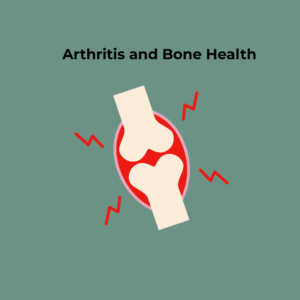Arthritis and Bone Health: What’s the Difference and What Can You Do?
Arthritis and Bone Health: What’s the Difference and What Can You Do?
When your body hurts, it can be hard to pinpoint exactly where the pain is coming from. Is it your joints? Your bones? Both?
Many people use the terms arthritis and bone loss interchangeably—but they’re two different issues that often overlap.
Knowing the difference between them can help you take better care of your body, seek the right treatment and prevent more serious problems later.
🦴 Bone Health vs. Joint Health
Here’s a simple way to think about it:
- Bone health refers to the strength, density, and structure of the bones themselves.
- Joint health refers to the places where bones meet and move together, cushioned by cartilage and surrounded by soft tissue. In medical terminology the word “arthro” means joint and so the prefix is used in many medical terms related to joints and conditions that affect them. Arthritis is an example.
Bones and joints work as a team—but they can each develop problems independently or at the same time.
🔎 What is Arthritis?
Arthritis simply means inflammation of the joints. It comes in many forms, including:
- Osteoarthritis (OA): wear and tear on the joint cartilage over time. Eventually the bone underneath the cartilage can be exposed to load and wear.
- Rheumatoid arthritis (RA): an autoimmune disease attacking the joints, particularly the joint linings.
- Psoriatic arthritis: inflammation related to psoriasis
- Gout: caused by uric acid crystals in the joints
When arthritis affects a joint, the cartilage cushions start breaking down, the bones may rub together, damage is created and inflammation processes go into full—leading to pain, stiffness, and reduced mobility.
🔎 What About Bone Loss?
Bone loss, or osteopenia/osteoporosis, happens when bones lose density and become weak, brittle, and more likely to fracture—even from minor falls.
While arthritis usually targets the joints, bone loss can weaken the bones that make up those joints—making arthritis symptoms worse and increasing the risk of fractures around affected joints.
🚨 How to Tell Which One You Have. Bone loss or Arthritis
Here are some clues:
| Symptom | More Likely Arthritis | More Likely Bone Loss |
| Pain location | In a specific joint | More widespread or deep in the bone |
| Pain with movement | Worse when moving joint | Sometimes worse even at rest |
| Stiffness | Often worse in the morning | Less likely |
| Fractures | Rare unless severe RA | Common with osteoporosis |
| Swelling or warmth | Common | Rare |
It’s also common to have both conditions at once, particularly as we age.
🩺 Why Does This Matter?
Because treatment and prevention strategies are different for arthritis and bone loss.
- Arthritis management focuses on reducing inflammation, maintaining joint mobility, and strengthening surrounding muscles.
- Bone health strategies focus on improving density, nutrition, posture, and fall prevention.
At Northcote Chiropractic Centre, we assess your posture, joint health, and spinal alignment to help identify which condition is contributing to your pain—and tailor a plan for both.
💪 3 Ways to Support Both Bones and Joints from Arthritis
1. Stay Active
Movement is medicine—for both bones and joints.
Exercises like walking, gym group classes, and resistance training help maintain joint flexibility and stimulate bone density.
2. Eat an Anti-Inflammatory, Bone-Friendly Diet
For arthritis: include omega-3-rich fish, turmeric, and leafy greens.
For bones: include calcium, vitamin D, and magnesium-rich foods.
3. Get Checked and Stay Aligned
Regular chiropractic care can help keep your joints mobile, your posture balanced, and your skeleton properly loaded—helping to ease arthritis symptoms while protecting bone strength.
✅ 3 Things You Can Do Today
- Book a chiropractic assessment – to check your joints, posture, and bone stress points
- Move daily – choose activities that are gentle yet weight-bearing
- Review your diet – reduce processed foods, add more calcium & omega-3s
Not sure if it’s your bones, your joints—or both? Let’s find out. Book a chiropractic check-up today and get a clear picture of what’s going on and how to feel better.

